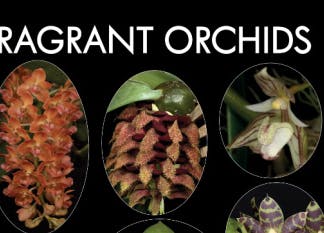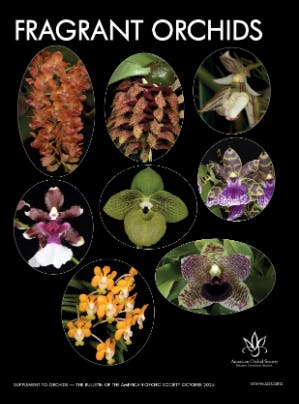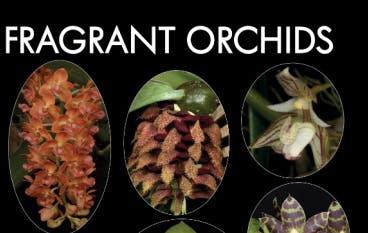
I REMEMBER THE mesmerizing scent of an orchid seducing me for the first time. It was a big Rhynchostylis gigantea at Fairchild Tropical Botanic Garden hanging near the doorway connecting two greenhouses. Once I discovered this orchid, I visited it in bloom every January, lingering in its vicinity to steal a few more breaths of that intoxicating fragrance. One year, it was not on display anymore and docents in the greenhouse could not tell me what happened to it, so that is when I decided to finally get one for myself. It was my first expensive orchid purchase.
As a novice orchid grower, my first Rhy. gigantea did not survive, and neither did the next two. I was determined to learn what this orchid needed to thrive so I could have that captivating fragrance in my own backyard every winter. Not only did I finally learn how to grow this orchid well, but I grew it well enough to win my first AOS award in 2018. It was a First Class Certificate. I gave it the clonal name ‘Claire de Lune’ and, in 2024, this peach-colored Rhynchostylis was awarded a Certificate of Cultural Excellence.
I cannot recommend which orchids to acquire for a fragrant collection, because fragrance is subjective. What delights me may be overpowering for you. A fragrance that I enjoy may be almost undetectable or even disagreeable to someone else. A fragrance-based collection is by its nature a uniquely personal collection. Also, we may have quite different growing conditions, so my choices may not do well for you. However, what I can do is describe how I built my fragrant orchid collection and share some of my personal favorites for readers to investigate.
My collection of several hundred orchids began as it does for many people: with gifts, “no I.D.” hand-me-downs, and divisions from friends. But when I became interested enough to go to orchid shows, I noticed it was my nose that did the shopping. If I passed by an orchid and it beckoned me to come back to take another sniff, I knew that I would probably want to take it home, providing I had the right conditions of temperature, light and available space for it to succeed in my South Florida backyard.
Although it was not essential, I decided I also had to love its appearance so that I would not begrudge caring for it when not in bloom. If both the fragrance and appearance delighted me, and if I believed I could offer the correct conditions, I brought it home. That is how my fragrant orchid collection began.
When I discovered that there was a huge selection of fragrant orchids across countless different genera in a vast array of colors, shapes, sizes, and scents, I knew that I could build a unique and interesting collection by deliberately focusing on the characteristic of fragrance. That is when I began to search actively for fragrant orchids to add to my young collection. I devoured the 2005 Steven A. Frowine book Fragrant Orchids and marked many orchids in that volume with Post-it notes. The orchid profiles there include many important categories for growers to be aware of such as temperature, light, size of the mature plant and a description of its fragrance and intensity. There are also several useful Appendices that focus on criteria such as Ease of Culture, Light Requirements, Nighttime Temperature Preferences, Intensity of Fragrance, Time of Fragrance and Season of Bloom that I found helpful.
When I discovered fragrant orchids that met my criteria at orchid society meetings or in the collections of friends, I added them to my shopping list. As with building any type of collection, it is necessary to be disciplined. I try to be mindful of my conditions and also my limitations of space, time and resources. Although I can sometimes be tempted, I try to exercise selectivity and stick to my shopping list. These days just a few orchids are on that list, because my collection is nearly full. Adding too many new ones means the need to divest myself of others. My wish list currently includes the rarely seen Scuticaria steelii and Galeandra devoniana. I became enchanted with these divinely fragrant orchids during the May 2023 Orchid Conservation Alliance Orchids in the Wild Ecotour on the Rio Negro River in the Brazilian Amazon. I immediately added them to my highly selective list, and I have been searching for them ever since. It is good that I am a patient collector who is willing to wait as long as it takes to find the objects of my desire.
[1] Rhynchostylis gigantea ‘Claire de Lune’ FCC-CCE/AOS belonging to the author

[2] Galeandra devoniana photographed in situ in the Brazilian Amazon.

[3] Scuticaria steelei photographed in situ in the Brazilian Amazon.

[4] Prosthechea sima ‘Lil’ CBR/AOS exhibited by the Marjorie McNeely Conservatory.

Not all fragrance is “nice.” Some scents are too sweet, like a cheap cologne that quickly gets tiresome. The Miltoniopsis that I gave to my sister was so floriferous and the fragrance so strong that she nicknamed it “Mr. Stinky” and put it outdoors on the patio when it bloomed. Prosthechea (Encyclia) sima, which I bought on the urging of the grower who just loved the fragrance, turned out to be so overpowering (for me) that I drive with the windows open when I take it for ribbon judging. I never liked using Coppertone sunscreen, so Maxillaria tenuifolia, with its coconut-scented fragrance, reminiscent of that product, is not hanging in my shade house. Some orchids, such as those bulbophyllums that are pollinated by flies, exude smells that are disagreeable to me, so those fascinating orchids are also not included in my collection.
The fragrances in my orchid collection represent a range of aromas that I happen to find pleasurable: citrusy, spicy, refreshing, sweet, fruity, vanilla, nutmeg, honey, lily-of-the-valley, and some that could only be characterized as indescribable or mysterious but intriguing (to me!). You may prefer other scents. Just as professional home organizer Marie Kondo asks if it sparks joy before discarding an item — I ask myself if this orchid and its fragrance brings me pleasure before adding it to my collection.
Flitting like a bee from flower to flower to sample the symphony of scents that abound in a fragrant orchid collection is a great way to start any day. Honey! Nutmeg! Lemon! Chocolate! Mint! Fresh laundry! Birthday candles! These scents and others call out for my attention. I know that these scents are there to attract pollinators, but they attract me too. Brassia Rex has a nice fragrance but, as it is rather light, it requires approaching quite close to even notice it. One morning I got a little too close and wound up getting pollinated! I thought the blur I was seeing was a smudge on my eyeglasses, but when I took them off to inspect they looked clean. It was not until later when I looked in the mirror that I noticed I had been tagged with a pollinarium on the tip of my nose!
Drinking in the scents of fragrant orchids sometimes means sharing the space with bees. I enjoy observing and photographing them foraging for pollen among the dense flowers of my Coelogyne rochussenii. A few minutes after arriving they look like they have put on cute little yellow backpacks. Euglossine orchid bees displaying their striking green metallic sheen also visit my orchids from time to time. I am fascinated by the way they hover like drones near the orchids that attract them.
Some orchids, such as my several beloved Rhy. gigantea, Prosthechea (Encyclia) radiata, Vanda tessellata and Dendrobium Banana Royal are fragrant all day long, while others like Maxillaria hennisiana, Dendrobium peguanum, Cattleya Canhamiana and Paraphadenia Juraj Kojs are most fragrant in the morning. Some orchids are fragrant only at night. Some start to exude fragrance as twilight sets in, whereas others begin later in the evening. Some, like Rhyncholaelia digbyana, are fragrant all night until just before the dawn of a new day. The time and duration of a flower’s fragrance depends on when its pollinators are active. For some orchid flowers, it takes 24–48 hours for their aroma to be released. Warm, humid conditions seem to enhance intensity, whereas highly airconditioned exhibition spaces tend to suppress fragrance.
[5] Some people find the fragrance of Maxillaria tenuifolia overpowering. Pictured is ‘Scarlet Coconut’ AM/AOS grown by Kathleen Snyder.

[6] Brassia caudata is another Brassia species with a light fragrance.

[7] A bee foraging in the author’s Coelogyne rochusenii. Note all the pollinia it has collected on its back. Photograph by the author.




My after-dark favorites include brassavolas such as nodosa and appendiculata (frequently mislabeled as cucullata), rhyncholaelias such as digbyana and glauca, Epidendrum ciliare (sometimes seen labeled with the synonym Coilostylis ciliaris) and Rhynchovola David Sander. The night garden is enchanting with its wildlife sights and sounds, and I appreciate that these night fragrant orchids lure me outside to experience a world that I would otherwise miss out on. In my opinion, there is no better night-fragrant orchid than Rl. digbyana. Not only is its scent intoxicating, but I enjoy observing its inflorescence slowly unfolding in all its showy fringy glory. The opening of a single flower is a memorable event that occurs over the course of the evening and entire night. I have set my alarm clock at two-hour intervals to witness the magical time-lapse opening of this remarkable flower. All that fringe looks so fragile, but these flowers are surprisingly long lasting, which is an added bonus.
[8] Dendrobium anosmum, often called Dendrobium superbum, has a powerful daytime fragrance.

[9] Dendrobium peguanum is a fragrant miniature that requires little room.

[10] Vandachostylis Lou Sneary was formerly a Neostylis before its parent, Vanda falcata was reclassified as a Vanda.

[11] Rhyncholaelia digbyana is the source of wonderful frilly lips in its hybrids, not to mention its spicy fragrance.

[12] Trichoglottis fasciata

[13] Rhyncholaeliocattleya Chia Lin

[14] Trichoglottis atropurpurea used to be called Trichoglottis brachiata.

Building any type of collection, including a fragrant orchid collection, will always be a work in progress. Take your time and make it your own, a collection that reflects your own unique tastes and preferences. Show off your collection to your friends and neighbors, most of whom are not aware that fragrant orchids even exist, since they only know phalaenopsis and hard-cane dendrobiums from big box stores.
The familiar advice to “slow down and make time to stop and smell the roses” could just as well apply to fragrant orchids. It is a metaphor for giving ourselves permission to enjoy the simple things that restore peace and balance to our hectic lives. Try taking an orchid fragrance break the next time you are feeling stressed out. Build a fragrant orchid collection of scents that you find soothing or stimulating and you will be able to indulge in orchid aromatherapy whenever you need it most.
— Claire Garrett has an eclectic collection of species and hybrid orchids that she grows outdoors in Hollywood, Florida in two shadehouses and under a giant bottlebrush tree. She is a member of the Fort Lauderdale Orchid Society and enjoys taking her orchids for AOS and show judging (email: clairegarr@aol.com).











